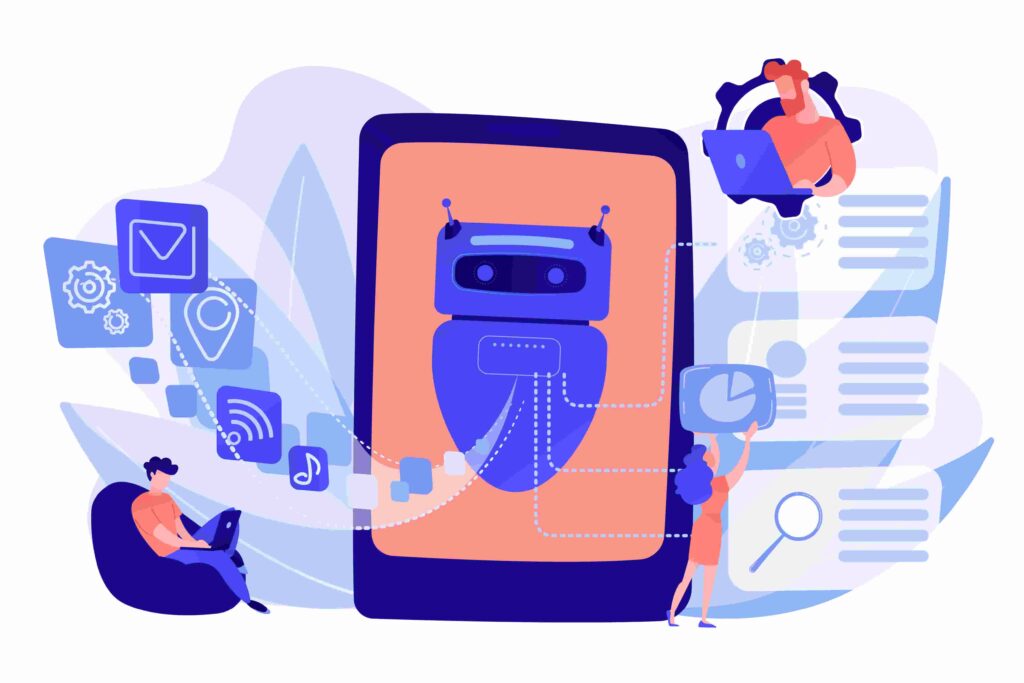In a world where fast communication is crucial, using chatbots in customer service is as an efficient alternative. After all, technology promises to change the way your company handles customer inquiries.
But does it really mean that your company can solve all customer service issues and needs? In this article, you will learn about the benefits and limitations of chatbots in customer service.
Can automation replace the personal touch that is often so important in customer service? Read this article to find out!
What is chatbot in customer service?
A customer service chatbot is a software tool designed to simulate human conversations and provide pre-programmed responses. Also known as a virtual assistant, or simply a bot, it can handle simple questions quickly and efficiently.
This way, chatbot service is based on the simulation of a dialog. For this reason, it has become a valuable ally for the customer service team, including agents and managers.
There are two main types of customer service chatbots. The first operates based on specific keywords, similar to automated FAQs. The second type is more advanced, using artificial intelligence to analyze the history of interactions and provide more accurate and contextual responses.
How does a customer service chatbot work?
The use of chatbots in customer service is becoming increasingly common, especially in channels like chat integrated into websites and WhatsApp. But how does this technology work?
Rule-based chatbots use predefined keywords that match a customer’s inquiry and generate ready-made responses. In other words, based on these words, the bot searches its database and sends a pre-programmed answer to the customer. If the tool is unable to identify a keyword registered in the system, it may respond with something like “Sorry, I didn’t understand your request.”
On the other hand, AI chatbots have a personalized knowledge base. In addition to learning from interactions, they provide more personalized and contextual responses that are tailored to the customer’s questions.
Therefore, the more customers interact with the AI-powered WhatsApp customer service chatbot, the more it learns. As a result, the tool provides increasingly accurate answers to customer questions, simulating human language.
Regardless of how it works, customer service chatbots can be configured to provide 24/7 support to customers. In this sense, some of the main uses of chatbots in customer service are:
- Collection of contact data;
- Service screening;
- Basic self-service tool;
- Answers to quick search for frequently asked questions, solutions, and shopping guides;
- Access to company information, such as address, phone number, social media page, and online store.
Benefits of chatbots in customer service
Using messaging channels such as WhatsApp and website chat to communicate with customers has a positive impact on customer experience. After all, these channels are part of the routine for many consumers, ensuring dynamic and fast service.
Using a chatbot in customer service on these channels can further improve this relationship. Here are some benefits of this tool for your pre- and post-sales departments:
-
Non-stop service
One of the main benefits of a customer service chatbot is the ability to provide continuous service. Regardless of the time of day or day of the week, the bot ensures that customers receive a response.
In other words, customers don’t have to wait for answers, avoiding frustration and lost sales. With chatbot automation, it’s possible to answer a high number of requests simultaneously.
All this without hiring additional staff or overloading the existing team. As a result, this technology ensures an efficient and consistent customer experience at no additional cost.
-
Fast L1 service
A customer service chatbot effectively accelerates Level 1 service. In other words, with pre-configured answers, it can answer simple and frequent questions quickly and accurately.
It means that by feeding the bot with information about products, order status or common questions, you can eliminate the excess of simple inquiries received by the customer service team.
As a result, agents can focus on more complex issues and the details of more nuanced requests. This way, the bot helps improve the overall efficiency of the departments and teams and reduce response time.
-
Easy to configure
Setting up a chatbot can be a simple process, especially with tools designed to make your life easier, such as Milvus. Our system offers an intuitive interface that allows you to create and set up a customer service chatbot by simply dragging and dropping text boxes, images, videos, and more.
In addition, this process doesn’t require a complex programming language. With a little planning and knowledge of your customers’ needs, you can implement an effective bot that meets the specific characteristics of your business.
-
Collect critical information from customers
Another benefit of customer service chatbots is that they automate the collection of important information from customers. All you have to do is program your chatbot tool to ask for important data during interactions, such as preferences and contact information.
It helps your company personalize service, improve marketing strategies, and speed up the sales process.
Can a chatbot solve all issues in customer service?
Using a chatbot in customer service can improve communication between your company and customers, with benefits for both. For instance, customers can get prompt support from chatbots on WhatsApp at any time of the day.
On the other hand, agents, freed from answering simple and repetitive questions, can focus on activities that require more attention. But does it mean this technology can solve all problems in customer-facing departments?
Well, it’s important to remember that customers are complex and their preferences vary. Therefore, it is essential to have humans behind the chatbot, configuring and updating the tool to ensure assertiveness.
Not to mention that a chatbot can’t make diagnoses, has no empathy, and only provides answers based on its database. So, humans are still essential to handle critical or non-obvious issues that require extra attention.
While chatbots don’t replace human interaction, they do increase employee productivity. Therefore, investing in team training remains critical to ensure team members are aligned with the company’s strategy.
With a well-trained and less overwhelmed team, motivation tends to increase, employee turnover decreases, and the customer experience improves. Finally, chatbots and humanized customer service can complement each other to deliver service excellence that benefits everyone.






